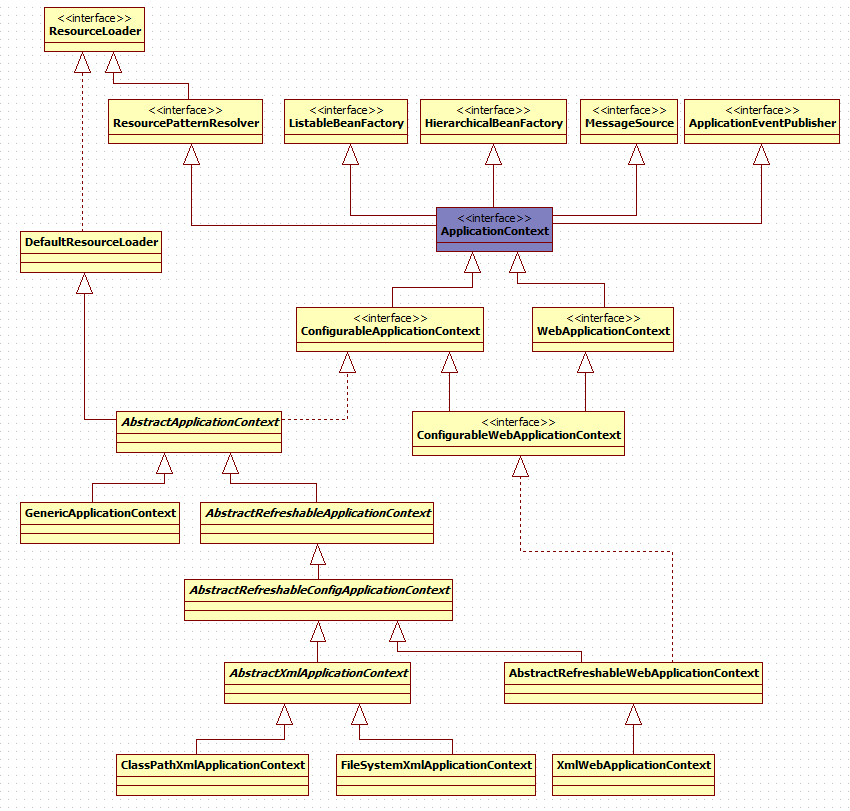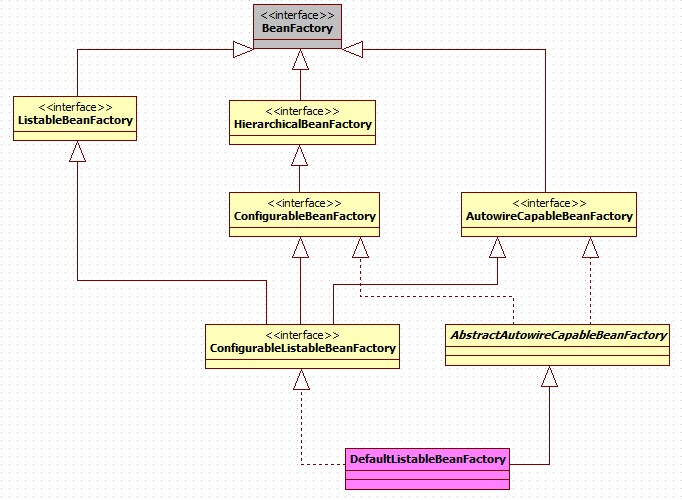注:本文分析的内容,针对的是Spring 2.5.6的版本
ApplicationContext是spring IoC容器的顶级接口,其类结构图如下:

从上面的类图中可以看出, ApplicationContext继承了ResourceLoader接口,便于获取外部资源;也间接继承了 BeanFactory接口,这样可以在Spring容器中创建Bean对象;同时也继承了ApplicationEventPublisher接口,用于发送一些事件消息。
通常我们使用这样的一行代码来创建并启动Spring容器:
1、prepareRefresh()
该方法所做的事情相对比较简单:记录容器启动的时间,并设置容器处于活跃状态。
2、obtainFreshBeanFactory()
该方法的作用:创建BeanFactory实例,并解析Spring的xml配置文件。beanFactory的实现类是:ConfigurableListableBeanFactory。方法的实现如下:

创建了beanFactory之后,通过调用AbstractXmlApplicationContext.loadBeanDefinitions方法,加载spring的xml配置文件,把用户通过配置文件定义的bean,解析成容器中以特定的数据结构描述的bean定义。AbstractXmlApplicationContext.loadBeanDefinitions方法的实现如下:

第二步, 创建ResourceEntityResolver,设置用于XML配置文件验证的实体分解器。该类的resolveEntity方法,实现对文档验证实体的转换:根据spring定义bean的xml配置文件中的“http://www.springframework.org/schema/beans”形式的url,从spring.jar包中的META-INF\spring.schema文件中,找到对应的DTD或XSD文件在本地的路径。
第三步,调用initBeanDefinitionReader方法,该方法是一个空实现,允许子类去覆盖,可以用来设置自定义的EntityResolver实现类,以及NamespaceHandlerResolver实现类。这也是spring的一个扩展点。
第四步,调用loadBeanDefinitions方法,该方法最终调用XmlBeanDefinitionReader.loadBeanDefinitions(EncodedResource)方法实现xml配置文件的加载及bean的注册,方法的实现如下:
至此,完成了BeanFactory实例的创建和Spring的xml配置文件的解析。
3、prepareBeanFactory
创建好 BeanFactory 后,接着调用prepareBeanFactory方法,添加一些 Spring 本身需要的一些工具类:
第一步,设置类加载器;
第二步,设置属性编辑器注册类,用来注册相关的属性编辑器。ResourceEditorRegistrar类,注册的属性编辑器如下:

第三步:设置内置的BeanPostProcessor:ApplicationContextAwareProcessor。该BeanPostProcessor的作用是,为实现特殊接口的bean,注入容器类(例如为实现ApplicationContextAware接口的类,注入ApplicationContext对象实例),如下:
第五步:调用registerResolvableDependency,注入特殊的对象。
4、postProcessBeanFactory
该方法是spring的一个扩展点之一,是一个空方法,留给子类去扩展。子类可以重写该方法,对已经构建的 BeanFactory 的配置根据需要进行修改。例如调用beanFactory.registerResolvableDependency,注入特殊的类。
ApplicationContext是spring IoC容器的顶级接口,其类结构图如下:

从上面的类图中可以看出, ApplicationContext继承了ResourceLoader接口,便于获取外部资源;也间接继承了 BeanFactory接口,这样可以在Spring容器中创建Bean对象;同时也继承了ApplicationEventPublisher接口,用于发送一些事件消息。
通常我们使用这样的一行代码来创建并启动Spring容器:
ApplicationContext context = new ClassPathXmlApplicationContext("applicationContext.xml"); public ClassPathXmlApplicationContext(String configLocation) throws BeansException {
this(new String[] {configLocation}, true, null);
}
public ClassPathXmlApplicationContext(String[] configLocations, boolean refresh, ApplicationContext parent)
throws BeansException {
super(parent);
setConfigLocations(configLocations);
if (refresh) {
refresh();
}
}public void refresh() throws BeansException, IllegalStateException {
synchronized (this.startupShutdownMonitor) {
//1、 Prepare this context for refreshing.
prepareRefresh();
//2、 Tell the subclass to refresh the internal bean factory.
ConfigurableListableBeanFactory beanFactory = obtainFreshBeanFactory();
//3、 Prepare the bean factory for use in this context.
prepareBeanFactory(beanFactory);
try {
//4、 Allows post-processing of the bean factory in context subclasses.
postProcessBeanFactory(beanFactory);
//5、 Invoke factory processors registered as beans in the context.
invokeBeanFactoryPostProcessors(beanFactory);
//6、 Register bean processors that intercept bean creation.
registerBeanPostProcessors(beanFactory);
//7、 Initialize message source for this context.
initMessageSource();
//8、 Initialize event multicaster for this context.
initApplicationEventMulticaster();
//9、 Initialize other special beans in specific context subclasses.
onRefresh();
//10、 Check for listener beans and register them.
registerListeners();
//11、 Instantiate all remaining (non-lazy-init) singletons.
finishBeanFactoryInitialization(beanFactory);
//12、 Last step: publish corresponding event.
finishRefresh();
}
catch (BeansException ex) {
// Destroy already created singletons to avoid dangling resources.
beanFactory.destroySingletons();
// Reset 'active' flag.
cancelRefresh(ex);
// Propagate exception to caller.
throw ex;
}
}
}1、prepareRefresh()
该方法所做的事情相对比较简单:记录容器启动的时间,并设置容器处于活跃状态。
2、obtainFreshBeanFactory()
该方法的作用:创建BeanFactory实例,并解析Spring的xml配置文件。beanFactory的实现类是:ConfigurableListableBeanFactory。方法的实现如下:
protected ConfigurableListableBeanFactory obtainFreshBeanFactory() {
refreshBeanFactory();
ConfigurableListableBeanFactory beanFactory = getBeanFactory();
if (logger.isInfoEnabled()) {
logger.info("Bean factory for application context [" + getId() + "]: " +
ObjectUtils.identityToString(beanFactory));
}
if (logger.isDebugEnabled()) {
logger.debug(beanFactory.getBeanDefinitionCount() + " beans defined in " + this);
}
return beanFactory;
} protected final void refreshBeanFactory() throws BeansException {
if (hasBeanFactory()) {
destroyBeans();
closeBeanFactory();
}
try {
DefaultListableBeanFactory beanFactory = createBeanFactory(); //1、创建beanFactory对象
customizeBeanFactory(beanFactory);
loadBeanDefinitions(beanFactory);//2、解析spring的xml配置文件,加载bean定义信息
synchronized (this.beanFactoryMonitor) {
this.beanFactory = beanFactory;
}
}
catch (IOException ex) {
throw new ApplicationContextException(
"I/O error parsing XML document for application context [" + getDisplayName() + "]", ex);
}
}
创建了beanFactory之后,通过调用AbstractXmlApplicationContext.loadBeanDefinitions方法,加载spring的xml配置文件,把用户通过配置文件定义的bean,解析成容器中以特定的数据结构描述的bean定义。AbstractXmlApplicationContext.loadBeanDefinitions方法的实现如下:
protected void loadBeanDefinitions(DefaultListableBeanFactory beanFactory) throws IOException {
// Create a new XmlBeanDefinitionReader for the given BeanFactory.
XmlBeanDefinitionReader beanDefinitionReader = new XmlBeanDefinitionReader(beanFactory); //1、创建BeanDefinitionReader对象
// Configure the bean definition reader with this context's
// resource loading environment.
beanDefinitionReader.setResourceLoader(this);
beanDefinitionReader.setEntityResolver(new ResourceEntityResolver(this)); // 2、设置xml文件schema的解析器,获取xsd文件。
// Allow a subclass to provide custom initialization of the reader,
// then proceed with actually loading the bean definitions.
initBeanDefinitionReader(beanDefinitionReader);
loadBeanDefinitions(beanDefinitionReader); //3、加载spring的xml配置文件,并解析。
}
第二步, 创建ResourceEntityResolver,设置用于XML配置文件验证的实体分解器。该类的resolveEntity方法,实现对文档验证实体的转换:根据spring定义bean的xml配置文件中的“http://www.springframework.org/schema/beans”形式的url,从spring.jar包中的META-INF\spring.schema文件中,找到对应的DTD或XSD文件在本地的路径。
第三步,调用initBeanDefinitionReader方法,该方法是一个空实现,允许子类去覆盖,可以用来设置自定义的EntityResolver实现类,以及NamespaceHandlerResolver实现类。这也是spring的一个扩展点。
第四步,调用loadBeanDefinitions方法,该方法最终调用XmlBeanDefinitionReader.loadBeanDefinitions(EncodedResource)方法实现xml配置文件的加载及bean的注册,方法的实现如下:
public int loadBeanDefinitions(EncodedResource encodedResource) throws BeanDefinitionStoreException {
Assert.notNull(encodedResource, "EncodedResource must not be null");
if (logger.isInfoEnabled()) {
logger.info("Loading XML bean definitions from " + encodedResource.getResource());
}
Set currentResources = (Set) this.resourcesCurrentlyBeingLoaded.get();
if (currentResources == null) {
currentResources = new HashSet(4);
this.resourcesCurrentlyBeingLoaded.set(currentResources);
}
if (!currentResources.add(encodedResource)) {
throw new BeanDefinitionStoreException(
"Detected recursive loading of " + encodedResource + " - check your import definitions!");
}
try {
InputStream inputStream = encodedResource.getResource().getInputStream();
try {
InputSource inputSource = new InputSource(inputStream);
if (encodedResource.getEncoding() != null) {
inputSource.setEncoding(encodedResource.getEncoding());
}
return doLoadBeanDefinitions(inputSource, encodedResource.getResource());
}
finally {
inputStream.close();
}
}
catch (IOException ex) {
throw new BeanDefinitionStoreException(
"IOException parsing XML document from " + encodedResource.getResource(), ex);
}
finally {
currentResources.remove(encodedResource);
if (currentResources.isEmpty()) {
this.resourcesCurrentlyBeingLoaded.set(null);
}
}
}
protected int doLoadBeanDefinitions(InputSource inputSource, Resource resource)
throws BeanDefinitionStoreException {
try {
int validationMode = getValidationModeForResource(resource);
Document doc = this.documentLoader.loadDocument(
inputSource, getEntityResolver(), this.errorHandler, validationMode, isNamespaceAware());
return registerBeanDefinitions(doc, resource);
}
catch (BeanDefinitionStoreException ex) {
throw ex;
}
catch (SAXParseException ex) {
throw new XmlBeanDefinitionStoreException(resource.getDescription(),
"Line " + ex.getLineNumber() + " in XML document from " + resource + " is invalid", ex);
}
catch (SAXException ex) {
throw new XmlBeanDefinitionStoreException(resource.getDescription(),
"XML document from " + resource + " is invalid", ex);
}
catch (ParserConfigurationException ex) {
throw new BeanDefinitionStoreException(resource.getDescription(),
"Parser configuration exception parsing XML from " + resource, ex);
}
catch (IOException ex) {
throw new BeanDefinitionStoreException(resource.getDescription(),
"IOException parsing XML document from " + resource, ex);
}
catch (Throwable ex) {
throw new BeanDefinitionStoreException(resource.getDescription(),
"Unexpected exception parsing XML document from " + resource, ex);
}
}
public void registerBeanDefinitions(Document doc, XmlReaderContext readerContext) {
this.readerContext = readerContext;
logger.debug("Loading bean definitions");
Element root = doc.getDocumentElement();
BeanDefinitionParserDelegate delegate = createHelper(readerContext, root);
preProcessXml(root);// 前置处理方法,是一个空实现
parseBeanDefinitions(root, delegate);<span><span class="comment">// 解析整个文档,循环处理各个子节点</span></span>
postProcessXml(root);// 后置处理方法,也是一个空实现
}
protected void parseBeanDefinitions(Element root, BeanDefinitionParserDelegate delegate) {
if (delegate.isDefaultNamespace(root.getNamespaceURI())) {
NodeList nl = root.getChildNodes();
for (int i = 0; i < nl.getLength(); i++) {
Node node = nl.item(i);
if (node instanceof Element) {
Element ele = (Element) node;
String namespaceUri = ele.getNamespaceURI();
if (delegate.isDefaultNamespace(namespaceUri)) {//<span><span class="comment">如果是默认名字空间(beans),则直接使用解析</span><span></span></span>
parseDefaultElement(ele, delegate);
}
else {
delegate.parseCustomElement(ele);//对于非默认名字空间,如util,使用对应的NamespaceHandlerResolver实现类的parse方法进行解析。
}
}
}
}
else {
delegate.parseCustomElement(root);
}
}
至此,完成了BeanFactory实例的创建和Spring的xml配置文件的解析。
3、prepareBeanFactory
创建好 BeanFactory 后,接着调用prepareBeanFactory方法,添加一些 Spring 本身需要的一些工具类:
protected void prepareBeanFactory(ConfigurableListableBeanFactory beanFactory) {
// Tell the internal bean factory to use the context's class loader.
beanFactory.setBeanClassLoader(getClassLoader());
// Populate the bean factory with context-specific resource editors.
beanFactory.addPropertyEditorRegistrar(new ResourceEditorRegistrar(this));
// Configure the bean factory with context callbacks.
beanFactory.addBeanPostProcessor(new ApplicationContextAwareProcessor(this));
beanFactory.ignoreDependencyInterface(ResourceLoaderAware.class);
beanFactory.ignoreDependencyInterface(ApplicationEventPublisherAware.class);
beanFactory.ignoreDependencyInterface(MessageSourceAware.class);
beanFactory.ignoreDependencyInterface(ApplicationContextAware.class);
// BeanFactory interface not registered as resolvable type in a plain factory.
// MessageSource registered (and found for autowiring) as a bean.
beanFactory.registerResolvableDependency(BeanFactory.class, beanFactory);
beanFactory.registerResolvableDependency(ResourceLoader.class, this);
beanFactory.registerResolvableDependency(ApplicationEventPublisher.class, this);
beanFactory.registerResolvableDependency(ApplicationContext.class, this);
// Detect a LoadTimeWeaver and prepare for weaving, if found.
if (beanFactory.containsBean(LOAD_TIME_WEAVER_BEAN_NAME) && JdkVersion.isAtLeastJava15()) {
// Register the (JDK 1.5 specific) LoadTimeWeaverAwareProcessor.
try {
Class ltwapClass = ClassUtils.forName(
"org.springframework.context.weaving.LoadTimeWeaverAwareProcessor",
AbstractApplicationContext.class.getClassLoader());
BeanPostProcessor ltwap = (BeanPostProcessor) BeanUtils.instantiateClass(ltwapClass);
((BeanFactoryAware) ltwap).setBeanFactory(beanFactory);
beanFactory.addBeanPostProcessor(ltwap);
}
catch (ClassNotFoundException ex) {
throw new IllegalStateException("Spring's LoadTimeWeaverAwareProcessor class is not available");
}
// Set a temporary ClassLoader for type matching.
beanFactory.setTempClassLoader(new ContextTypeMatchClassLoader(beanFactory.getBeanClassLoader()));
}
}第一步,设置类加载器;
第二步,设置属性编辑器注册类,用来注册相关的属性编辑器。ResourceEditorRegistrar类,注册的属性编辑器如下:
public void registerCustomEditors(PropertyEditorRegistry registry) {
ResourceEditor baseEditor = new ResourceEditor(this.resourceLoader);
registry.registerCustomEditor(Resource.class, baseEditor);
registry.registerCustomEditor(InputStream.class, new InputStreamEditor(baseEditor));
registry.registerCustomEditor(File.class, new FileEditor(baseEditor));
registry.registerCustomEditor(URL.class, new URLEditor(baseEditor));
ClassLoader classLoader = this.resourceLoader.getClassLoader();
registry.registerCustomEditor(Class.class, new ClassEditor(classLoader));
registry.registerCustomEditor(URI.class, new URIEditor(classLoader));
if (this.resourceLoader instanceof ResourcePatternResolver) {
registry.registerCustomEditor(Resource[].class,
new ResourceArrayPropertyEditor((ResourcePatternResolver) this.resourceLoader));
}
}
第三步:设置内置的BeanPostProcessor:ApplicationContextAwareProcessor。该BeanPostProcessor的作用是,为实现特殊接口的bean,注入容器类(例如为实现ApplicationContextAware接口的类,注入ApplicationContext对象实例),如下:
public Object postProcessBeforeInitialization(Object bean, String beanName) throws BeansException {
if (bean instanceof ResourceLoaderAware) {
((ResourceLoaderAware) bean).setResourceLoader(this.applicationContext);
}
if (bean instanceof ApplicationEventPublisherAware) {
((ApplicationEventPublisherAware) bean).setApplicationEventPublisher(this.applicationContext);
}
if (bean instanceof MessageSourceAware) {
((MessageSourceAware) bean).setMessageSource(this.applicationContext);
}
if (bean instanceof ApplicationContextAware) {
((ApplicationContextAware) bean).setApplicationContext(this.applicationContext);
}
return bean;
}第五步:调用registerResolvableDependency,注入特殊的对象。
4、postProcessBeanFactory
该方法是spring的一个扩展点之一,是一个空方法,留给子类去扩展。子类可以重写该方法,对已经构建的 BeanFactory 的配置根据需要进行修改。例如调用beanFactory.registerResolvableDependency,注入特殊的类。